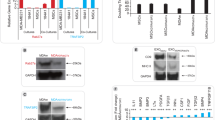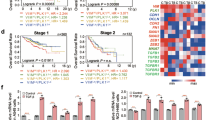Abstract
Tumor necrosis factor (TNF)-alpha-induced protein 8-like 2 (TNFAIP8L2; also termed TIPE2) has been shown to be involved in both the immune-negative modulation and cancer. We previously found that TIPE2 is lost in human gastric cancer, and TIPE2 restoration suppresses gastric cancer growth by induction of apoptosis and impairment of protein kinase B (PKB/AKT) and extracellular signal-regulated kinase-1/2 (ERK1/2) signaling. However, its correlation with epithelial–mesenchymal transition (EMT) in gastric cancer is largely elusive. In the present report, we carried out a gain-of-function study in AGS and HGC-27 human gastric cancer cells by adenovirus-mediated human TIPE2 gene transfer (AdVTIPE2). We then examined the effects of AdVTIPE2 on in vitro migration and invasion of AGS and HGC-27 tumor cells by wound-healing assay and Transwell invasion assay, respectively. We also investigated the effects of AdVTIPE2 on in vivo lung metastasis of AGS and HGC-27 tumor cells by intravenous (i.v.) injection in athymic BALB/c nude mice. We demonstrated that AdVTIPE2 remarkably suppressed the migratory, invasive and metastatic potential of AGS and HGC-27 tumor cells in vitro and in vivo in BALB/c nude mouse model. Mechanistically, AdVTIPE2 obviously upregulated E-cadherin epithelial marker in AGS and HGC-27 tumor cells, whereas it downregulated N-cadherin and Vimentin mesenchymal markers, Snail1, Snail2/Slug and Zeb1 EMT-inducing transcription factors (EMT-TFs), and tripartite motif-containing 29 (TRIM29) and phosphatase regenerating liver 3 (PRL-3) gastric cancer-specific metastasis markers. Importantly, glycogen synthase kinase-3β (GSK-3β) inhibitor VIII and 26S proteasome inhibitor MG132 assays revealed that TIPE2 downregulated Snail1 and Snail2/Slug in a GSK-3β- and proteasome-dependent manner possibly by impairing AKT signaling. Our data provided the first evidence that TIPE2 inhibits gastric cancer cell migration, invasion and metastasis very probably via reversal of EMT, revealing that TIPE2 may be a novel therapeutic target for human gastric cancer EMT and metastasis.
This is a preview of subscription content, access via your institution
Access options
Subscribe to this journal
Receive 12 print issues and online access
$259.00 per year
only $21.58 per issue
Buy this article
- Purchase on Springer Link
- Instant access to full article PDF
Prices may be subject to local taxes which are calculated during checkout






Similar content being viewed by others
References
Sun H, Gong S, Carmody RJ, Hilliard A, Li L, Sun J et al. TIPE2, a negative regulator of innate and adaptive immunity that maintains immune homeostasis. Cell 2008; 133: 415–426.
Freundt EC, Bidere N, Lenardo MJ . A different TIPE of immune homeostasis. Cell 2008; 133: 401–402.
Lou Y, Liu S . The TIPE (TNFAIP8) family in inflammation, immunity, and cancer. Mol Immunol 2011; 49: 4–7.
Wang Z, Fayngerts S, Wang P, Sun H, Johnson DS, Ruan Q et al. TIPE2 protein serves as a negative regulator of phagocytosis and oxidative burst during infection. Proc Natl Acad Sci USA 2012; 109: 15413–15418.
Sun H, Zhuang G, Chai L, Wang Z, Johnson D, Ma Y et al. TIPE2 controls innate immunity to RNA by targeting the phosphatidylinositol 3-kinase-Rac pathway. J Immunol 2012; 189: 2768–2773.
Lou Y, Zhang G, Geng M, Zhang W, Cui J, Liu S . TIPE2 negatively regulates inflammation by switching arginine metabolism from nitric oxide synthase to arginase. PLoS ONE 2014; 9: e96508.
Luan YY, Yao YM, Zhang L, Dong N, Zhang QH, Yu Y et al. Expression of tumor necrosis factor-alpha induced protein 8 like-2 contributes to the immunosuppressive property of CD4(+)CD25(+) regulatory T cells in mice. Mol Immunol 2011; 49: 219–226.
Luan YY, Yao RQ, Tong S, Dong N, Sheng ZY, Yao YM . Effect of tumor necrosis factor-alpha induced protein 8 like-2 on immune function of dendritic cells in mice following acute insults. Oncotarget 2016; 7: 30178–30192.
Li D, Song L, Fan Y, Li X, Li Y, Chen J et al. Down-regulation of TIPE2 mRNA expression in peripheral blood mononuclear cells from patients with systemic lupus erythematosus. Clin Immunol 2009; 133: 422–427.
Li F, Zhu X, Yang Y, Huang L, Xu J . TIPE2 alleviates systemic lupus erythematosus through regulating macrophage polarization. Cell Physiol Biochem 2016; 38: 330–339.
Ma Y, Liu X, Wei Z, Wang X, Wang Z, Zhong W et al. The expression and significance of TIPE2 in peripheral blood mononuclear cells from asthmatic children. Scand J Immunol 2013; 78: 523–528.
Ding J, Su J, Zhang L, Ma J . Crocetin activates Foxp3 through TIPE2 in asthma-associated treg cells. Cell Physiol Biochem 2015; 37: 2425–2433.
Lou Y, Liu S, Zhang C, Zhang G, Li J, Ni M et al. Enhanced atherosclerosis in TIPE2-deficient mice is associated with increased macrophage responses to oxidized low-density lipoprotein. J Immunol 2013; 191: 4849–4857.
Lou Y, Sun H, Morrissey S, Porturas T, Liu S, Hua X et al. Critical roles of TIPE2 protein in murine experimental colitis. J Immunol 2014; 193: 1064–1070.
Xi W, Hu Y, Liu Y, Zhang J, Wang L, Lou Y et al. Roles of TIPE2 in hepatitis B virus-induced hepatic inflammation in humans and mice. Mol Immunol 2011; 48: 1203–1208.
Zhang W, Zhang J, Zhao L, Shao J, Cui J, Guo C et al. TIPE2 protein negatively regulates HBV-specific CD8(+) T lymphocyte functions in humans. Mol Immunol 2014; 64: 204–209.
Gus-Brautbar Y, Johnson D, Zhang L, Sun H, Wang P, Zhang S et al. The anti-inflammatory TIPE2 is an inhibitor of the oncogenic Ras. Mol Cell 2012; 45: 610–618.
Alderton GK . Tumour immunology: suppressing tumorigenic inflammation. Nat Rev Cancer 2012; 12: 228.
Cao X, Zhang L, Shi Y, Sun Y, Dai S, Guo C et al. Human tumor necrosis factor (TNF)-alpha-induced protein 8-like 2 suppresses hepatocellular carcinoma metastasis through inhibiting Rac1. Mol Cancer 2013; 12: 149.
Li Y, Li X, Liu G, Sun R, Wang L, Wang J et al. Downregulated TIPE2 is associated with poor prognosis and promotes cell proliferation in non-small cell lung cancer. Biochem Biophys Res Commun 2015; 457: 43–49.
Liu QQ, Zhang FF, Wang F, Qiu JH, Luo CH, Zhu GY et al. TIPE2 Inhibits Lung Cancer Growth Attributing to Promotion of Apoptosis by Regulating Some Apoptotic Molecules Expression. PLoS ONE 2015; 10: e0126176.
Deng B, Feng Y . TIPE2 mediates the suppressive effects of Shikonin on MMP13 in osteosarcoma cells. Cell Physiol Biochem 2015; 37: 2434–2443.
Zhao Q, Zhao M, Dong T, Zhou C, Peng Y, Zhou X et al. Tumor necrosis factor-alpha-induced protein-8 like-2 (TIPE2) upregulates p27 to decrease gastic cancer cell proliferation. J Cell Biochem 2015; 116: 1121–1129.
Zhu Y, Tao M, Wu J, Meng Y, Xu C, Tian Y et al. Adenovirus-directed expression of TIPE2 suppresses gastric cancer growth via induction of apoptosis and inhibition of AKT and ERK1/2 signaling. Cancer Gene Ther 2016; 23: 98–106.
Peng Y, Zhao Q, Zhang H, Han B, Liu S, Han M . TIPE2, a negative regulator of TLR signaling, regulates p27 through IRF4-induced signaling. Oncol Rep 2016; 35: 2480–2486.
Zhang YH, Yan HQ, Wang F, Wang YY, Jiang YN, Wang YN et al. TIPE2 inhibits TNF-alpha-induced hepatocellular carcinoma cell metastasis via Erk1/2 downregulation and NF-kappaB activation. Int J Oncol 2015; 46: 254–264.
Li XM, Su JR, Yan SP, Cheng ZL, Yang TT, Zhu Q . A novel inflammatory regulator TIPE2 inhibits TLR4-mediated development of colon cancer via caspase-8. Cancer Biomark 2014; 14: 233–240.
Zhang Z, Qi H, Hou S, Jin X . TIPE2 mRNA overexpression correlates with TNM staging in renal cell carcinoma tissues. Oncol Lett 2013; 6: 571–575.
Li X . TIPE2 regulates tumor-associated macrophages in skin squamous cell carcinoma. Tumour Biol 2016; 37: 5585–5590.
Xie Y, Sheng W, Miao J, Xiang J, Yang J . Enhanced antitumor activity by combining an adenovirus harboring ING4 with cisplatin for hepatocarcinoma cells. Cancer Gene Ther 2011; 18: 176–188.
Zhang H, Zhou X, Xu C, Yang J, Xiang J, Tao M et al. Synergistic tumor suppression by adenovirus-mediated ING4/PTEN double gene therapy for gastric cancer. Cancer Gene Ther 2016; 23: 13–23.
Hanahan D, Weinberg RA . Hallmarks of cancer: the next generation. Cell 2011; 144: 646–674.
Lamouille S, Xu J, Derynck R . Molecular mechanisms of epithelial-mesenchymal transition. Nat Rev Mol Cell Biol 2014; 15: 178–196.
Kosaka Y, Inoue H, Ohmachi T, Yokoe T, Matsumoto T, Mimori K et al. Tripartite motif-containing 29 (TRIM29) is a novel marker for lymph node metastasis in gastric cancer. Ann Surg Oncol 2007; 14: 2543–2549.
Dai N, Lu AP, Shou CC, Li JY . Expression of phosphatase regenerating liver 3 is an independent prognostic indicator for gastric cancer. World J Gastroenterol 2009; 15: 1499–1505.
Zhou BP, Deng J, Xia W, Xu J, Li YM, Gunduz M et al. Dual regulation of Snail by GSK-3beta-mediated phosphorylation in control of epithelial-mesenchymal transition. Nat Cell Biol 2004; 6: 931–940.
Yook JI, Li XY, Ota I, Hu C, Kim HS, Kim NH et al. A Wnt-Axin2-GSK3beta cascade regulates Snail1 activity in breast cancer cells. Nat Cell Biol 2006; 8: 1398–1406.
Kao SH, Wang WL, Chen CY, Chang YL, Wu YY, Wang YT et al. GSK3beta controls epithelial-mesenchymal transition and tumor metastasis by CHIP-mediated degradation of Slug. Oncogene 2014; 33: 3172–3182.
Fayngerts SA, Wu J, Oxley CL, Liu X, Vourekas A, Cathopoulis T et al. TIPE3 is the transfer protein of lipid second messengers that promote cancer. Cancer Cell 2014; 26: 465–478.
Moniz LS, Vanhaesebroeck B . A new TIPE of phosphoinositide regulator in cancer. Cancer Cell 2014; 26: 443–444.
Zhang Z, Liang X, Gao L, Ma H, Liu X, Pan Y et al. TIPE1 induces apoptosis by negatively regulating Rac1 activation in hepatocellular carcinoma cells. Oncogene 2015; 34: 2566–2574.
Chaffer CL, Weinberg RA . A perspective on cancer cell metastasis. Science 2011; 331: 1559–1564.
De Craene B, Berx G . Regulatory networks defining EMT during cancer initiation and progression. Nat Rev Cancer 2013; 13: 97–110.
Mendez MG, Kojima S, Goldman RD . Vimentin induces changes in cell shape, motility, and adhesion during the epithelial to mesenchymal transition. FASEB J 2010; 24: 1838–1851.
Puisieux A, Brabletz T, Caramel J . Oncogenic roles of EMT-inducing transcription factors. Nat Cell Biol 2014; 16: 488–494.
Peinado H, Olmeda D, Cano A . Snail, Zeb and bHLH factors in tumour progression: an alliance against the epithelial phenotype? Nat Rev Cancer 2007; 7: 415–428.
Acknowledgements
This research work was supported by grants from the National Natural Science Foundation of China (NNSFC) (No. 81372443, 81001016, 81272542 and 81572992), the Science and Technology Department of Jiangsu Province (No. BL2014039 and BY2015039-03), the Pushin HK Jiangsu Medical Technology. (No. P112200315) and the Wu Jieping Medical Foundation (No. P112200914).
Author information
Authors and Affiliations
Corresponding authors
Ethics declarations
Competing interests
The authors declare no conflict of interest.
Rights and permissions
About this article
Cite this article
Yin, H., Huang, X., Tao, M. et al. Adenovirus-mediated TIPE2 overexpression inhibits gastric cancer metastasis via reversal of epithelial–mesenchymal transition. Cancer Gene Ther 24, 180–188 (2017). https://doi.org/10.1038/cgt.2017.3
Received:
Revised:
Accepted:
Published:
Issue Date:
DOI: https://doi.org/10.1038/cgt.2017.3
This article is cited by
-
RNA-Seq transcriptome analysis shows anti-tumor actions of melatonin in a breast cancer xenograft model
Scientific Reports (2019)
-
Overexpression of MAP3K3 promotes tumour growth through activation of the NF-κB signalling pathway in ovarian carcinoma
Scientific Reports (2019)
-
Knockdown of TIPE2 increases the proliferation in lipopolysaccharide-stimulated gastric cancer cells
BMC Cancer (2018)



